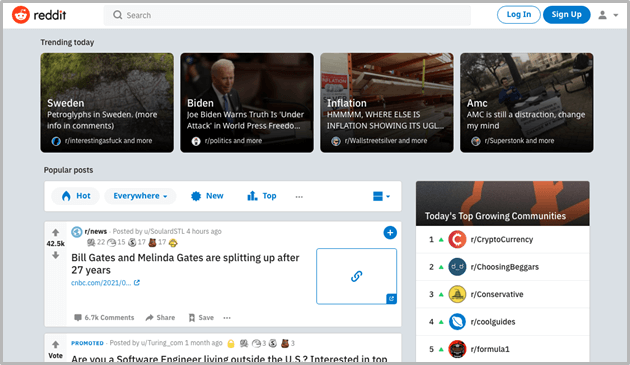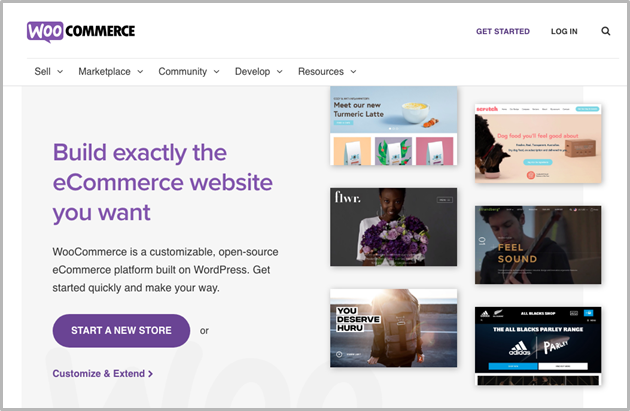This may be the best moment to learn how to start an eCommerce business! Partly because of the pace technology evolves, but also because of external factors such as the COVID pandemic.
According to information from eCommerceCEO the online sales market will reach $6.8 trillion by 2023. That’s why this is the best moment to start your own digital business.
Let us draw you a road map with this step-by-step guide.
1- Choose The Right Products
Finding the right product to start your eCommerce business is not an easy task. You have to do a lot of research and pay attention to new trends.
Start Simple
Think of the niches and communities you’re already in. Are you a member of a soccer team, a chess club, or a manga community? Think about the things you and your team struggle with the most… is there any product that can help you put the uniform quicker, draw faster, or store your chess set better?
Avoid The Generic Route.

Instead, go for products that are hard to find on Amazon, eBay, or any popular eCommerce website. As we mentioned before, you can find products right away if you think of the niches and communities you belong to.
2- Find The Right Niche For Your eCommerce Store

Not all products will work for all audiences. The search for a niche has to be tied up to the product from the beginning. Even if your product is a brand new invention that everybody should have.
Let’s say you decided to sell a smartphone lens to take photos. Start following photography profiles on Instagram or join a photography community on Facebook!
One great way to find both: niches and products is by joining online forums, like reddit.com

Finding the right niche is important! Because it is an excellent place to find people already interested in your product and because getting community feedback is an unending source of ideas for new products.
3- Set Up Your eCommerce Brand And Business

People keep choosing apple products over more generic brands because we all know what quality to expect from them. That’s what a well-built brand can make for you. Here are some of the steps that will help you build a strong business and a good brand image.
Pick Up A Name
Your store name doesn’t have to be the legal name of your business, but we suggest you keep them related. Remember your niche research and use a name related to that.
Register Your Business
After choosing a name, you need to register your business. This can offer huge benefits as legal protection and tax benefits.
Get All The Licenses And Permits Up To Date
Getting all your business documentation in order is the best way to avoid unpleasant surprises.
There are a lot of resources you can access at the Small business Administration, including a guide to help you register your business. You can also find mentors and information about almost anything related to the start-up world.
Develop Your Brand Identity

This is an important part of the process if you want to stand out from the competition. Developing a brand identity can also help you connect with your audience at a more personal level.
Develop A Good Content Strategy
This is going to sound counterintuitive, but the best way to sell is by not trying to sell.
Let me explain. We all hate when people try to sell anything to us, right? But -you may ask- how can I connect with my customers if not by selling them something?
And the answer is very simple: Trough high-quality content.
The hard selling “push” strategies that our parents used in the ’90s don’t work anymore. People are tired of brands trying desperately to get our attention. Instead of that, what you should do is develop a “pull” strategy.
That means, instead of using ads as a spear to hunt your customers… develop good content that works as bait, and let them come to you. Do not push your brand on them, let them fall in love with it.
Remember, good and abundant content is the reason why you have never seen ads for Instagram or TikTok.
4- Set Up Your Ecommerce Platform

Let us break the pros and cons of those three options.
By Your Own
This is the best option for people with advanced developer skills. You can have control over everything from the domain to the payment methods, to the server. Keep in mind this is also the most time-consuming option since you need to take care of things like copywriting and graphic design.
- Ideal for people with coding skills
- You can choose the exact features and plugins your store needs
Cons
- Need to know to code
- Time-consuming
- You also need copywriting and graphic design skills
- It can become very expensive
Using an Ecommerce Platform
There are eCommerce platforms that do some of the heavy liftings for you, so you can just focus on delivering a great experience to your customers. While some of them offer great advantages for starters, if you choose the wrong one, you can find a lot of limitations when you want to grow or diversify your business.
Pros
- Easy for beginners
- Some of them also offer payment and shipping methods
Cons
- Some of them present limitations to grow or expand
- You need to pay a monthly fee or a commission for every product sold
- Your e-store is not entirely yours
Hiring A Professional Web Designer

Pros:
- Absolute control of your e-store
- You can have the exact features you want
- They take care of everything
- No coding skills needed
Cons:
- Good professionals are hard to find
Whether you choose any of those options, here’s a roadmap with a broad view of the things you may need to take care of before starting.
Get Your Domain Name And Url
The best thing you can do is to choose your business name and domain at the same time. This way you can be sure it will be available. Although if you already have a brand and just want to get the domain, you can play a little with characters and words.
Remember to keep it simple and short. That’s the best way to make sure people will remember your brand.
There are many ways to look for a domain. If you are creating your e-store on your own, you can use Google Domain or GoDaddy to check availability. If you are using an eCommerce platform, some of them can help you get the domain you want, and many also include this as part of their service.
If you have a web designer it’s even easier because they can take care of everything and even present you with creative options for a domain.
Questions To Find The Right Platform

If you are using an eCommerce platform, there are a couple of things to keep in mind to find the right one for your business.
As always our best advice is to hire a professional, but if you want to start with an eCommerce platform, here are some things you should ask first.
- Is this platform easy to set up?
Be careful to choose a platform that offers ease of use for your skill level, or at least good customer service. - Is it easy to design and navigate?
Check the templates they offer and take a look at the actual stores built on that platform to be sure the stores work and the pages are easy to browse. - Is it secure for my customers?
Check your page has “HTTPS” instead of “HTTP” and also check the lock icon on the address bar. If you don’t have those, people won’t trust you with their card numbers. - Does it integrate with other platforms?
Not all eCommerce platforms are compatible with all apps and platforms. Check yours can integrate with the other sites and services you want to use. - Does this platform allow me to use SEO?
This is a really important aspect since SEO is one of the best ways to drive people to your website. Make sure the platform you use, allows you to run SEO campaigns. - Is my store responsive?
Most online purchases are made on a mobile device. That’s the reason why it is so important to make sure your page looks good on all of them. - How easy is it to talk to someone at tech support?
Get ready to find all kinds of technical problems mostly at the beginning. Make sure you can contact someone to help you, or at least to check if they offer any type of learning resources.
You can also check these 5 key aspects you should consider to start in eCommerce to get a better idea of all the things you need before starting.
Experts Choice: Woocommerce

After many trials and errors, a lot of professional web designers choose woocommerce. This platform is well known because of how easy it is to use for starters, but also because of its robust features that make it an excellent choice for everyone.
Here are some of the reasons why as professionals, Woocommerce is the best option:
- User Friendly
It’s interface was developed to help everyone get the job done easily. It is easy to download and install, and it’s learning curve is way friendlier than the other ecommerce platforms. - Customizable
Because it is an open source system, you can customize it to work exactly as you want. The best part is that you can customize it by using plug-ins, which means you don’t even need coding skills. - Open Source
As it is an open source system, chances are the plugin you want has already been developed by someone else. It will work even better if you have coding skills or a web designer who knows how to add and remove them. - Affordable
Woocommerce is free to download and install. This is undoubtedly one of the main reasons behind its popularity. However there are thousands of plugins you can use, and some of them may have a cost.
5 – Develop An Ecommerce Marketing Strategy
Let’s say your store is all about technology and gadgets. Then maybe you want to join tech and gadgets groups on Facebook, or start posting videos of your products under the #Technology hashtag on Instagram.
Social Media

One big advantage of using social media to promote your store is how easy it is for starters. You can start investing as little as $10 and get some results.
Although you don’t need to invest in paid advertising. You can Look for Facebook groups, Instagram profiles related to your business and use related TikTok sounds to get more people interested in your business.
SEO Strategy
Search Engine Optimization (SEO) is about using search engines to reach more potential customers.
Let’s say your product is artistic candles. You want to develop an SEO strategy that shows your store every time somebody types “colorful candle” in google.
How?
The best way so far is with high-quality content. Start a blog about your product, and take advantage of the available SEO tools. Let us share with you 4 tips about how to write SEO-optimized articles for your blog.
Use The Right Words In The Right Places
Look for the keywords related to your product and write about that. You can use tools like Answer the public to find out.

Write Concise Titles And Meta Descriptions
The Meta description is the short text under the URL in the google search results page. It doesn’t have a direct influence on SEO but is vital to let people know what your article is about.
You can use the SERP preview tool High-Quality to get the right size for your headlines and meta descriptions

Deliver High-Quality Content
Google algorithms always favor high-quality content. Avoid copy-pasting from other sites since google sees that as plagiarism, and it can damage your Google ranking.
If you want to learn more about how to write great pieces of content for your SEO strategy, we wrote this guide to help you write better content.
Before You Start -7 Advanced eCommerce Tips
1. Better Ideas Lead To Better Products And Services
And the only way to have good ideas is by trying a lot of them. Don’t be afraid of trying new things. Keep in mind some of them won’t work but can give you valuable insights.
2. Focus Not On Your Product But On Your Customers

Also, remember customers value the products and services that deliver a broadened experience. Weather is a unique packaging or a socially responsible brand.
3. The Importance Of A Good Brand Identity
Developing a brand puts a name behind the products you are selling, but it also has huge benefits! You can access tax and legal benefits as a registered business. But it also helps you develop brand awareness and reach much more customers.
4. People Trust Reviews More Than Whitepapers
No surprises here. We are more eager to trust our neighbor’s opinion before getting a new lawnmower, than a hundred salesmen.
Many commerce platforms allow you to show your reviews from Google or Yelp. And most of them ask your customers to leave reviews. Don’t be afraid to show the best ones and share them on social media.
5. Good Web Design Always Wins

6. Read Your Audience’s Mind
Remember your audience won’t necessarily write the description of your product. They will write what they want. For instance, if your product is a purifier water bottle, don’t use the keyword “purifier water bottle”
Use instead
“The best way to get drinking water in the wild”
7. Don’t Underestimate Your Seo Strategy
The correct SEO strategy can put you right where your customers are looking for. Remember to follow the guidelines and avoid any type of plagiarism since it can affect your ranking in Google.
Conclusion
This is maybe the best moment in history to start your own online business. And now, you know exactly which steps to follow.
If you are interested in automation tools for your online business, check this article about the best automation tools for eCommerce
Let us know which step you liked the most, and follow us on social media to ask anything about the article! We’ll be glad to help you.
__________________________________________
Sources:
https://www.shopify.com/blog/eCommerce-business-blueprint
https://www.eCommerceceo.com/start-eCommerce-business/
https://www.oberlo.com/blog/eCommerce-how-to-start-and-succeed
https://neilpatel.com/blog/how-to-build-a-successful-eCommerce-brand-from-scratch/
https://www.investopedia.com/best-eCommerce-platforms-5092528
https://www.freshegg.co.uk/blog/web-development/getting-started-with-e-commerce



